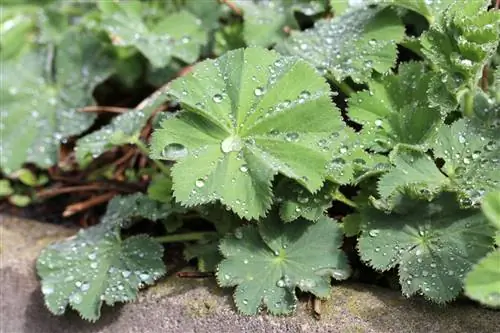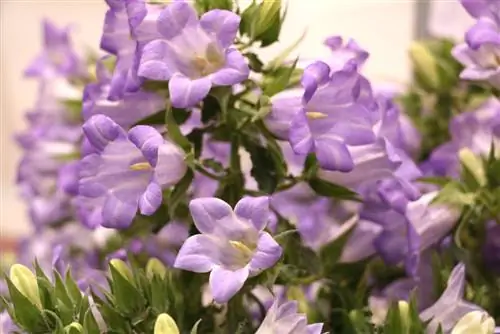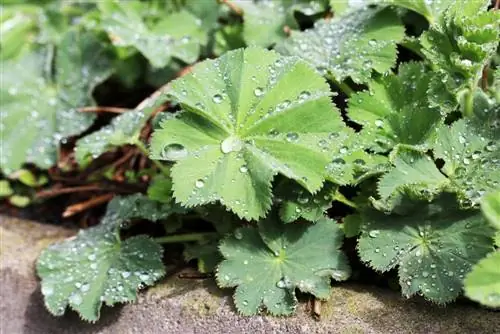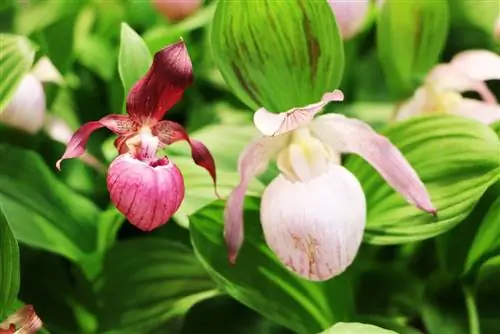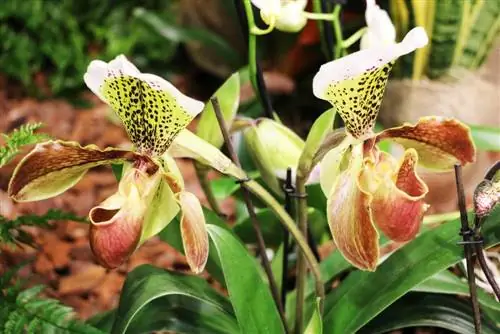- Author admin [email protected].
- Public 2023-12-17 03:39.
- Last modified 2025-01-24 12:45.
Mariebellflowers are biennial plants that bloom for weeks in a sunny location and are also persistent in the vase. They willingly fill in small gaps in the flower bed, often by sowing themselves year after year. The care is manageable and feasible.
Lifespan
The lady's bellflower, scientifically known as Campanula medium, comes from the bell family. We also know some other family members from the garden, mostly as perennial, herbaceous perennials. The St. Mary's bellflower, which originally comes from southern Europe, only has a two-year lifespan.
Growth habit and flowers
If you decide to cultivate Campanula medium, you should know that it will be flowerless and rather inconspicuous for the first year. At first only a low rosette consisting of green, long leaves forms. Only in the second year does it sprout a 50 to 90 cm long and branched flower stalk, along which numerous large, bell-shaped flowers are lined up from June to July. Depending on the variety, they are white, pink, purple or blue.
Tip:
Some gardeners may find it disappointing that the flowers of the lady's bellflower have no scent at all, even though they magically attract bees and butterflies. But on the other hand, for exactly this reason they are ideal for gardens that are maintained by people with pollen allergies.
Selection of varieties
The Campanula medium varieties primarily play with color tones, with some producing double flowers that look like two bells placed one inside the other. Seeds are usually sold mixed in stores as a so-called splendid mixture. Here is a small selection of varieties:
- 'Blue Cups': flower stalks up to 75 cm high; deep blue flowers
- 'Calycanthema': bears double flowers in different colors
- 'Caerulea': blue, double flowers, loves sun
- 'Champion Pink': pink-flowering; loves wetter soils
- ‘White Double’: white, double flowers; long flowering period from May to August
Seed sowing / propagation
Campanula medium is sown in a seed or cold frame in May at the earliest. However, sowing is still possible until July. The seeds germinate in light and are only lightly covered with soil. It is important that the temperature for germination is between 15 and 18 °C. The seeds need consistently moist soil. This is best achieved if the sowing site is covered with fleece. As soon as the seedlings are around 2-3 weeks old, they are separated at a distance of 10 cm. In August, the larger young plants are transplanted into the flower bed, where they will remain and bloom permanently. Incidentally, sowing seeds is the only method of propagating the Mary flower. The division practiced with perennials does not work with this bellflower.
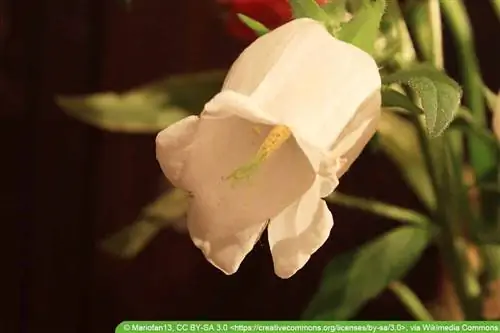
Location and soil
The location for this bellflower should be sunny to partially shaded and definitely warm. The space should be large enough to allow a planting distance of 30-40 cm, as Campanula medium grows bushy to pyramid-shaped. The floor must be as follows:
- nutrient-rich
- well-drained, not prone to waterlogging
- if applicable mix with sand
- neutral to slightly alkaline pH value
Tip:
Very long flower stems can bend on windy days. Prevent this by tying her to a small stick.
Planting in pots
A lady's bellflower lasts two years in a pot and brightens up every terrace and balcony with its rich blooms. To ensure that your roots don't get too wet, the pot should have a large drainage hole and a drainage layer of coarse gravel, clay or perlite at the bottom. Mix commercial potting soil with sand to make it more permeable. If the pot is large enough, it can be planted in it together with other plants.
Good planting neighbors
Campanula medium fits wonderfully into cottage gardens and natural gardens. There it can be easily combined with other plants to create a varied, colorful flower bed. Examples of good neighbors are:
- Turkish Poppy
- True Sage
- Roses
- Flameflower
Other types of plants, whether annual flowers or perennials, with a preference for sun are also suitable as transplants.
Wintering
This bellflower must first survive a cold winter before it blooms. If the thermometer falls far below zero, she can freeze to death. In rough areas, cover them with brushwood early. Potted plants should generally be wrapped in warming fleece and placed in a protected place.
Pouring
Both in the first and second year, lady's bell flowers in the garden bed only need extra water when the days are very warm and dry. Lady's bell flowers in pots need to be watered regularly and depending on the weather. The tried and tested finger test also reliably helps here to lift the watering can at the right time.
Tip:
If the plant is in a planter or on a saucer, you should pour away all excess water shortly after watering.
Fertilize
Before planting, the soil can be enriched with compost, then fertilization no longer needs to be carried out in the first year. The following year, a portion of slow-release fertilizer in good time at the beginning of the growing season is sufficient. Even then, a portion of compost is best. But horn shavings and other fertilizers can also be used.
Mariebell flowers in pots or balcony boxes are regularly supplied with a liquid fertilizer for flowering plants from April onwards. Dosage and frequency should be based on the manufacturer’s instructions. It is usually enough to fertilize with water once a week.

Cutting
The growth habit of Campanula medium cannot be positively influenced by cutting, so it is not necessary to cut this flower. But the flowering period can be made even more lush with the help of scissors.
- wilted flowers spoil the look
- subsequent seed formation costs energy
- Flowered flowers should therefore be removed promptly
- Saved energy is invested in new flowers
You can cut he althy flower stems whose bell-shaped flowers are just opening for the vase at any time. These bluebells last for many days. Alone or decoratively mixed with other cut flowers.
Tip:
If you want to have lady's bell flowers in the garden in future years without doing much about it, leave a few wilted flowers. Capsule fruits will form, which will open when the seeds are ripe and thus ensure self-sowing.
Diseases
Marinebell flowers are susceptible to some fungal diseases. These include rust, downy mildew and gray mold. If the known home remedies do not help, you should remove affected plants from the flower bed. The use of chemicals is not worthwhile as it would cause a lot of damage to nature. The plant would only have a short life ahead of it anyway.
Pests
In years when there are a lot of slugs, lady's bell flowers also fall victim to the voracious pests. Every gardener has his own control method with which he tries to eliminate these slimes from the garden. If you are not familiar with this, you will find countless tips in specialist literature or on the internet. If there are only a few animals, it is best to collect them immediately and take them far away. This gives you the opportunity to lay your eggs, from which a new snail plague can grow.


